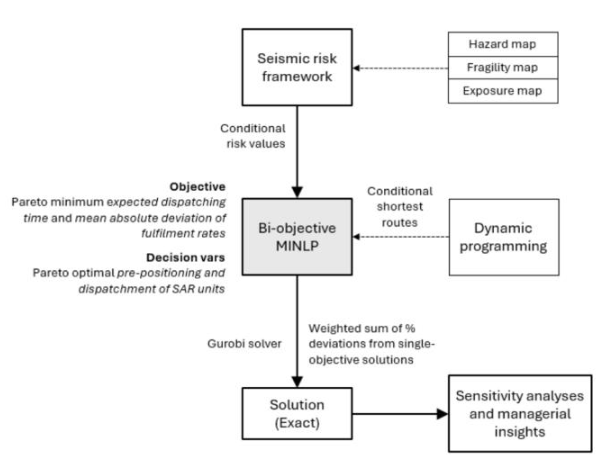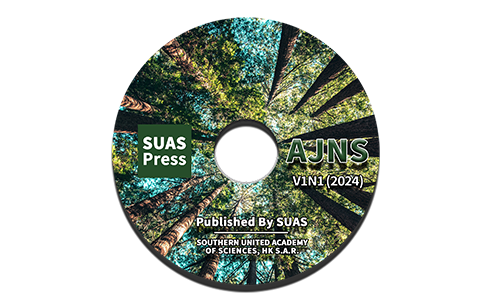Integrating Stochastic Programming and Machine Learning for Enhanced Pre-disaster Relocation Planning
DOI:
https://doi.org/10.70393/616a6e73.323631ARK:
https://n2t.net/ark:/40704/AJNS.v2n1a02Disciplines:
Computer ScienceSubjects:
Artificial IntelligenceReferences:
27Keywords:
Stochastic Programming, Machine Learning, Pre-disaster Relocation, Flooding Risk Management, Resident Relocation Behavior, Decision Analysis, Predictive Analytics, Gradient Boosting, Decision Trees, Proactive Relocation StrategiesAbstract
This paper proposes a novel framework that integrates stochastic programming and machine learning to optimize pre-disaster relocation strategies. Building upon existing game-theoretic and decision analysis models, this study presents a two-stage stochastic programming model coupled with predictive analytics to manage uncertainties associated with flooding risks and resident relocation behaviors. Machine learning algorithms, such as decision trees and gradient boosting, are employed to capture the variability in residents' decision-making, enhancing the precision of subsidy and policy impact forecasts. This combined approach offers governments innovative tools for implementing cost-effective, proactive relocation measures that mitigate long-term social and economic disruption. Additionally, by leveraging stochastic programming's robust handling of uncertainty and machine learning's data-driven insights, the framework ensures that relocation policies are both adaptive and equitable, addressing diverse community needs and long-term resilience planning.
Downloads
Metrics
References
Cen, Z., & Zhao, Y. (2024). Investigating the Impact of AI-Driven Voice Assistants on User Productivity and Satisfaction in Smart Homes. Journal of Economic Theory and Business Management, 1(6), 8-14.
Aydın, N. S. (2024). A seismic-risk-based bi-objective stochastic optimization framework for the pre-disaster allocation of earthquake search and rescue units. Mathematical Modelling and Numerical Simulation with Applications, 4(3), 370-394.
Jiang, Z., & Ji, R. (2024). Optimising hurricane shelter locations with smart predict-then-optimise framework. International Journal of Production Research, 1-21.
Yazdani, M., Kabirifar, K., & Haghani, M. (2024). Optimising post-disaster waste collection by a deep learning-enhanced differential evolution approach. Engineering Applications of Artificial Intelligence, 132, 107932.
Acharya, K., Velasquez, A., Liu, Y., Liu, D., Sun, L., & Song, H. (2024). Improving Air Mobility for Pre-Disaster Planning with Neural Network Accelerated Genetic Algorithm. arXiv preprint arXiv:2408.00790.
Yazdani, M., Shahriari, S., & Haghani, M. (2024). Real-time decision support model for logistics of emergency patient transfers from hospitals via an integrated optimisation and machine learning approach. Progress in Disaster Science, 100397.
Wan, H., Liu, W., Zhang, S., Qie, D., Shi, Q., & Cheng, R. (2025). Pre-disaster allocation and post-disaster dispatch strategies of power emergency resources for resilience enhancement of distribution networks. Electric Power Systems Research, 238, 111038.
Liu, H. Y., Wu, Z., & Yu, L. N. (2024). Optimization of emergency stockpile siting: A review of models, influencing factors, and future research directions. J. Eng. Manag. Syst. Eng, 3(4), 226-235.
Pandey, S., Pandey, P. C., Costache, R., Arora, A., Ranjan, P., Chamoli, A., & Pandey, M. (2024). An Overview of Machine Learning Applications in Disaster Waste Management. Geo-information for Disaster Monitoring and Management, 469-499.
Kumarasinghe, S., Jayasinghearachchi, V., & Ratnayaka, P. (2023). Pre-Disaster and Risk Detection Using AI Prediction System. International Research Journal of Innovations in Engineering and Technology, 7(11), 154.
Huang, D., Wang, S., & Liu, Z. (2021). A systematic review of prediction methods for emergency management. International Journal of Disaster Risk Reduction, 62, 102412.
Cen, Z., & Zhao, Y. (2024). Enhancing User Engagement through Adaptive Interfaces: A Study on Real-time Personalization in Web Applications. Journal of Economic Theory and Business Management, 1(6), 1-7.
Zhao, Y., & Cen, Z. (2024). Exploring Multimodal Feedback Mechanisms for Improving User Interaction in Virtual Reality Environments. Journal of Industrial Engineering and Applied Science, 2(6), 35-41.
Lin, W., Xiao, J., & Cen, Z. (2024). Exploring Bias in NLP Models: Analyzing the Impact of Training Data on Fairness and Equity. Journal of Industrial Engineering and Applied Science, 2(5), 24-28.
Zhao, Y., & Wu, J. (2024). Enhancing User Engagement and Behavior Change in Healthy Eating Apps: A Human-Computer Interaction Perspective. Journal of Industrial Engineering and Applied Science, 2(6), 27-34.
Xiao, J., Zhang, B., Zhao, Y., Wu, J., & Qu, P. (2024). Application of Large Language Models in Personalized Advertising Recommendation Systems. Journal of Industrial Engineering and Applied Science, 2(4), 132-142.
Zhao, Y., Qu, P., Xiao, J., Wu, J., & Zhang, B. (2024). Optimizing Telehealth Services with LILM-Driven Conversational Agents: An HCI Evaluation. Journal of Industrial Engineering and Applied Science, 2(4), 122-131.
Zhao, Y., Wu, J., Qu, P., Zhang, B., & Yan, H. (2024). Assessing User Trust in LLM-based Mental Health Applications: Perceptions of Reliability and Effectiveness. Journal of Computer Technology and Applied Mathematics, 1(2), 19-26.
Wu, J., & Xiao, J. (2024). Application of Natural Language Processing in Network Security Log Analysis. Journal of Computer Technology and Applied Mathematics, 1(3), 39-47.
Xiao, J., & Wu, J. (2024). Transfer Learning for Cross-Language Natural Language Processing Models. Journal of Computer Technology and Applied Mathematics, 1(3), 30-38.
Wu, J., Qu, P., Zhang, B., & Zhou, Z. (2024). Sentiment Analysis in Social Media: Leveraging BERT for Enhanced Accuracy. Journal of Industrial Engineering and Applied Science, 2(4), 143-149.
Zhang, B., Yan, H., Wu, J., & Qu, P. (2024). Application of Semantic Analysis Technology in Natural Language Processing. Journal of Computer Technology and Applied Mathematics, 1(2), 27-34.
Qu, P., Zhang, B., Wu, J., & Yan, H. (2024). Comparison of Text Classification Algorithms based on Deep Learning. Journal of Computer Technology and Applied Mathematics, 1(2), 35-42.
Zhong, Y. N. (2024). Optimizing the Structural Design of Computing Units in Autonomous Driving Systems and Electric Vehicles to Enhance Overall Performance Stability. International Journal of Advance in Applied Science Research, 3, 93-98.
Zhong, Y. (2024). Enhancing the Heat Dissipation Efficiency of Computing Units Within Autonomous Driving Systems and Electric Vehicles.
Wang, X., Li, X., Wang, L., Ruan, T., & Li, P. (2024). Adaptive Cache Management for Complex Storage Systems Using CNN-LSTM-Based Spatiotemporal Prediction. arXiv preprint arXiv:2411.12161.
Wang, L., Xu, Z., Stone, P., & Xiao, X. (2024). Grounded curriculum learning. arXiv preprint arXiv:2409.19816.

Downloads
Published
How to Cite
Issue
Section
ARK
License
Copyright (c) 2025 The author retains copyright and grants the journal the right of first publication.

This work is licensed under a Creative Commons Attribution 4.0 International License.














